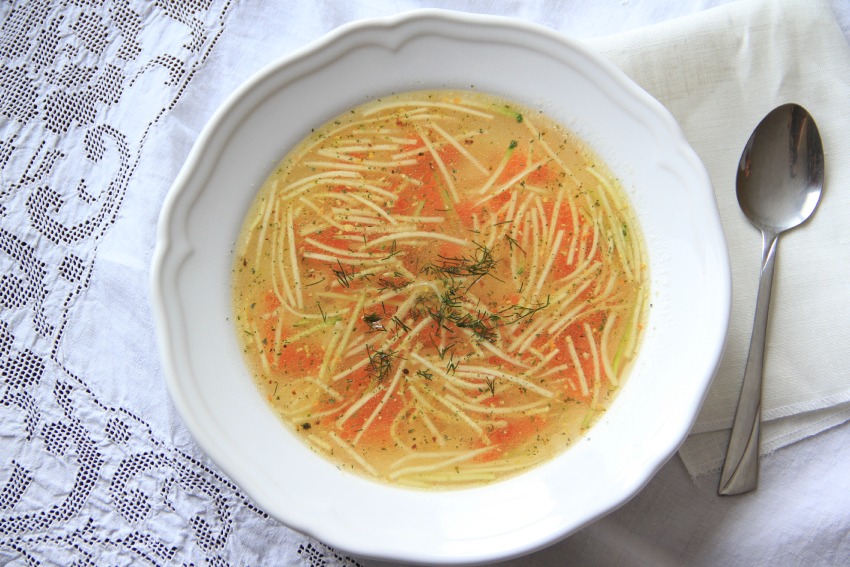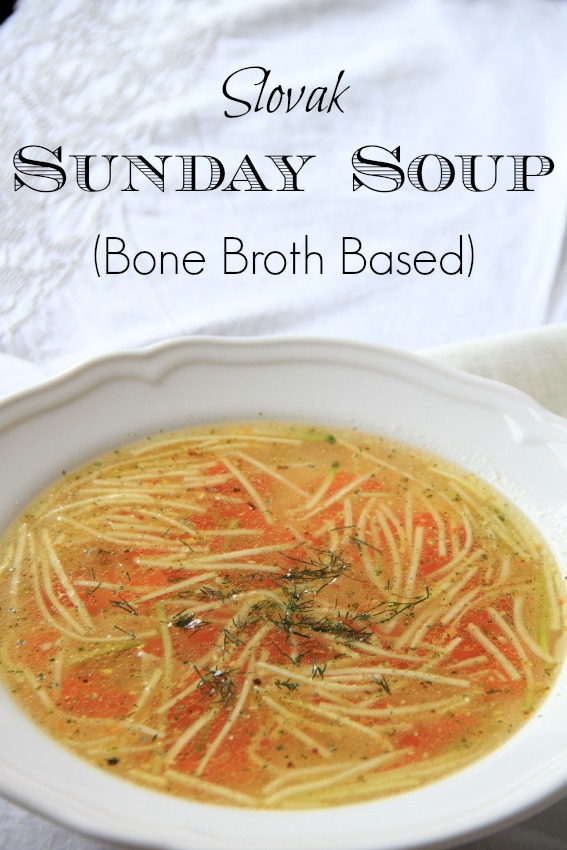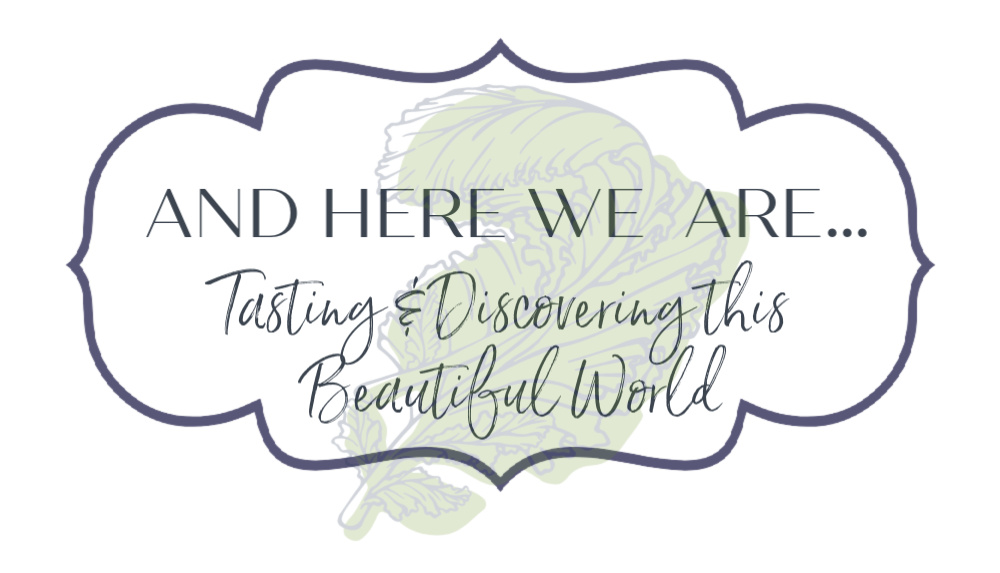Hi Everyone! As you know, we are in the midst of our transition to living in Spain right now. We’re in ournew home, and we’re working on getting settled in and the 101 details that come with this season. In the meantime, I have some guest posts I’m excited to share with you, on the topic of our experiences At The Table, a continuation of celebrating the release of my cookbook.
This guest post is from Naomi of Almost Bananas. I love reading her stories about life in Slovakia, and her photos are gorgeous. Definitely go have a look at her beautiful site!
This clear bone broth based soup is a staple for any celebration in Slovakia, including Sundays. While some of us might be after the nutrition and digestion benefits, here it’s just a traditional way to eat a meal with family and friends.

As I grow older, live in far away countries, and see close connections pass away, connecting with family and close friends becomes more important to me.
As a child in rural Canada, I grew up in a large extended family that regularly got together at my grandparent’s farm. Cousins ran everywhere, adults talked about whatever they talked about, and we all had our fill of heaping piles of food. Later the instruments came out and adults played music while we children listened and capered to traditional Scottish tunes.
As an adult now, I appreciate that my husband’s family also gets together often. Babichka (Grandma) prays for good weather so that when the large brood of grandchildren descends upon the house, they can play outside. Adults catch up on news, coats pile up, and feet trip over copious shoes.
Many elements of the family gatherings are the same. Lots of energetic cousins. Lots of food. Lots of connecting with people who, despite sometimes driving you nuts, you still come back to because they are family.
A few elements are very different, however. One is the formal greeting in Slovakia, given even among family members. Men shake hands, women/men and women clasp hands and kiss each other on each cheek (in the East men kiss as well, and there are three kisses instead of two). When one family enters the house, everyone gathers around for their turn to greet hello, including the children.
Another differing element is the formality of eating. In Canada we would often eat potluck style, balancing a plate wherever there was room, on the porch, in the living room, or leaning against the kitchen counter. In Slovakia, lunch is always the main meal and everyone sits down together to a formally set table. A wide shallow bowl site atop a plate, with fork, knife, and spoon. Napkins might be simply placed or folded into some fancy shape if someone has taken the time to fold a tall stack of napkins.
The extended family has outgrown space and plates, so we often sit in shifts, first the children, who both are dying of hunger and then impatient to run off and play, and after the more sedentary adults, who linger talking over the meal. “Obed! Podte sa najest!” “Lunch! Come eat!” rings the call in various parts of the house and yard. The hungry ones come quickly and sit waiting, the distracted ones take their time. The sound of chattering children, clinking cutlery, and creaking chairs fills the air.
The first course is always the same – a clear bone based brothy soup. A massive pot has sat over heat for three to four hours, with just an occasional bubble breaking to the surface. Some bones, water, salt, and vegetables are all it takes to create this staple of Slovak cuisine.
My mother in law makes this soup every Sunday and for celebratory occasions, even during the summer. The wedding soup is the same but, I’ve heard, has seven kinds of bones in it, including wild pheasant, rooster, beef, and boar. Even during the week soup is the first course at lunch, even in school cafeterias, although unfortunately no longer made with bones.
Most Slovaks aren’t aware the of benefits of starting a meal with bone broth, such as healing the gut wall, aiding digestion, and supporting healthy connective tissue. It’s just what they’ve always done. I hope that they learn, in order to help consciously maintain the tradition.
And I hope they – and we all – continue to sit together with others over a meal, whether family or not. Sharing a meal together gives us a context within which to share our lives with others; a way to build the community that celebrates with us in joy and supports us in sorrow; a place to cultivate those connections that give our lives meaning and purpose.

Slovak Sunday Bone Broth Soup
- Use only raw bones. No roasting bones beforehand, no leftovers from roasted carcasses. The flavour is different.
- Use bones from any animal, preferably raised in a sustainable manner. Pork, beef, poultry, go for it, you can even mix types.
- A bit of fat (or skin) and meat on the bones adds flavour.
- Note that the vegetables are put in whole, or cut in half, don’t cut them up when putting the soup together.
- If you don’t have parsley root, parsnips would do as well. If you don’t have either, leave it out.
- The more vegetables go in at the beginning, the sweeter the broth will be, you can choose as many or as little as you like. I save green cabbage cores or cauliflower stems in the freezer and throw them in as well.
- I’ve used zucchini noodles although traditionally thin egg noodles are used.
- This recipe is for three liters / quarts
What You’ll Need
- a 3 L/quart stockpot
- bones (roughly 600-900 g/20-32 oz)
- salt
- 1 onion
- chunk celery root, 1/2 kohlrabi, cabbage core, etc
- parsley top
- 4-6 carrots
- 2-3 parsley root
- 1 small zucchini
- dried vegetable flavoring (this is the kind I use, and this would work well, too)
- parsley for garnish
What to Do:
1. Wash bones, place in pot and fill 3/4 with cold water. Add about 1+1/2 tbsp of salt (more or less to preference) and set over low heat. The broth should never boil away, only have the occasional bubble rise to the top. If it does boil, of course it’s still tasty, but the broth will be cloudy instead of clear.
2. Add a peeled onion cut in half, the first vegetables (celery root, kohlrabi, cabbage core, etc), and parsley top (if you have one). Leave the broth on low heat for at least 3-4 hrs, if not longer.
3. About an hour before serving, add carrots and parsley root. Do not slice, although you can cut them in half lengthwise if they are bigger.
4. Make zucchini noodles and cut into 2 inch/5 cm lengths. I like to put them in a sieve and put the sieve into the broth for a few minutes to warm up and soften the noodles but not cook them.
5. Strain out the carrots and parsley root, cool for a minute, and chop. Put carrots, parsley, and zucchini noodles in a soup tureen, large mixing bowl, or another pot.
6. Ladle the hot broth through a sieve into the soup tureen, sprinkle some dried vegetable flavoring and/or salt to taste, add a handful of chopped parsley.
7. Serve piping hot. Hot pepper can be added to individual bowls if desired.
Would you like to try more Slovak dishes? How about Creamy Sauerkraut Stew, Chicken Paprikash, or Cauliflower with Feta Sauce.
![]() A Canadian transplanted to Slovakia, Naomi aims to cook real food and create an environmentally friendly and beautiful home for her family of six. The closest she’s come to her dream farm is growing tasty live bacteria on the counters. The simple life is an elusive ideal that she nevertheless continues to strive toward, although two year old twins make sure it’s never boring. Naomi shares her food creations and life in Slovakia at Almost Bananas. She looks forward to connecting with you on Pinterest, Facebook, and Instagram.
A Canadian transplanted to Slovakia, Naomi aims to cook real food and create an environmentally friendly and beautiful home for her family of six. The closest she’s come to her dream farm is growing tasty live bacteria on the counters. The simple life is an elusive ideal that she nevertheless continues to strive toward, although two year old twins make sure it’s never boring. Naomi shares her food creations and life in Slovakia at Almost Bananas. She looks forward to connecting with you on Pinterest, Facebook, and Instagram.
Thank you so much for sharing your family’s traditions and recipe with us, Naomi! This sounds totally delicious.


My Polish ancestors always started their dinners with a bowl of broth with noodles. My mom continued the tradition, but only on Sunday. It’s also a tradition amongst my Italian friends to drink a cup of brodo (broth) before Sunday dinner.
I think many European cultures had clear bone soups, I only know about the Slovak version in more detail. So many great traditions!
p.s. the old folks always valued a very clear broth, so no boiling allowed, just a bare simmer like you said.
Absolutely delicious! Bone broth is amazing stuff and I loved reading about the traditions around this delicious soup 🙂 I’ll be adding some zucchini noodles when I make this, can’t wait to try the recipe.
Thanks! Bone broth is amazing stuff, I just run out of bones too quickly. Hope you enjoy!
Can I have the recipe for creamy sauerkraut stew please
Hi Christine, you can find the recipe for the creamy sauerkruat stew here: https://www.almostbananas.net/creamy-sauerkraut-stew-slovak-segedinsky-gulash/
I remember as a child eating this soup my grandmother made its was such broth and she made some haluski noodles with it then after words eating the beef meat afterwards for me with ketchup. Lol. But I never knew what it was called nor have ever been able to create it. My mom came close but she is now gone also.
We did the same as well. Im Slovak and our whole family meal was different courses from the soup. Maybe justvbrothband noodles or added the vegetables. Then the meat from the soup with maybe some of the carrots or potatoes from the broth. And or course a good bread.
We always had our soup on Saturday. I too can remember taking the meat out after finishing the broth and eating it with ketchup! It was always called poluka (sp) in our house.
I see the diversity of food culture from places. I am very respectful and interesting with that. The new things are really attractive to me, this is a soup dish worth trying once in my life. Thank you
Naomi, you brought many childhood memories of our Sunday soup! We would eat the marrow on a piece of rye bread. Do you know what the marrow is called in Slovak? I am having a hard time remembering the right word.
Thank you!
I only remember the sound of the word my grandfather used when he spread the bone marrow on his bread. The spelling is not close but he called it “szhpick”.
We always spread the marrow on bread and ate it, sometimes with a little mustard. I remember we called it “spic” but surely am not spelling it correctly.
thank you for all the organ recipes …we buy from a farmer each year a side of beef & he practically gives us all the organs- tongue,heart, liver we want…also many many bones….I like you different ideas on how to cook…when I cook the tongue it does not last long as I simply start putting a good mustard on the hot tongue and then before I know it it is gone….we cannot get sweet breads or brain, since the mad cow panic the health board in Massachusetts will not allow the butchers to process…thank you, I bet it is a real treat to sit at your table…..jim
I used to know an old woman from slovenia that made the most delicious soup. it made with many cuts of meat , carrots and some onion.maybe other veges . she would slow cook it hours then strain it. she made tiny noodles with dough she shredded on a box grater, she called it something like ribakasha . have you heard of this soup?